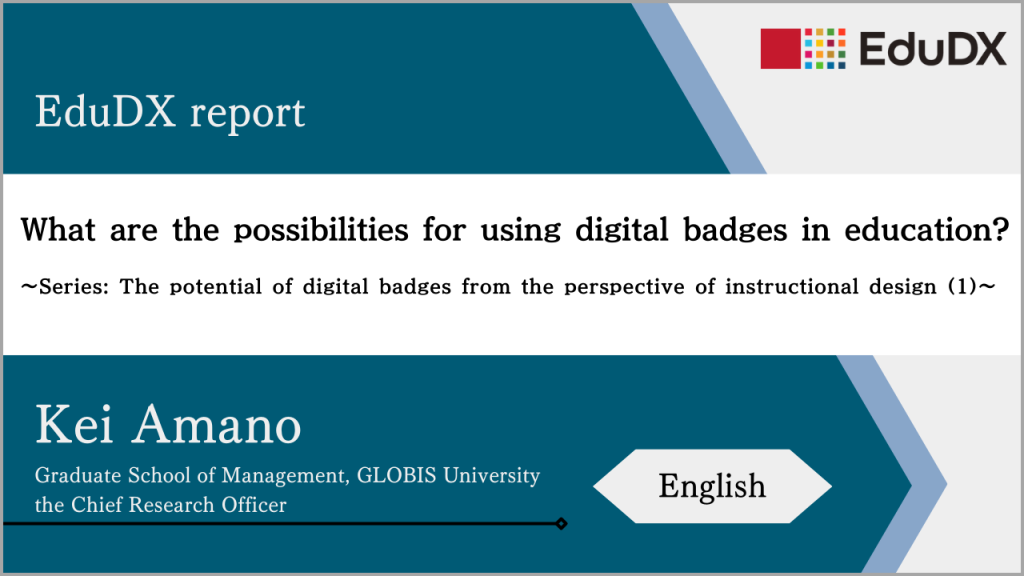What are the possibilities for using digital badges in education?
~Series: The potential of digital badges from the perspective of instructional design (1) ~

31 January 2024, Kei Amano (Graduate School of Management, GLOBIS University the Chief Research Officer)
Do you know about digital badges? There have been numerous tracks concerning digital badges in the Online Learning Forum, which is held annually in the fall and consists of seminars introducing the latest e-learning trends. Moreover, newspapers have introduced examples of companies using digital badges to visualize employee skills in human resource development. If you are interested in online education, you have probably heard of the term “digital badge”
In addition to the original question, we would also like to explore the topic further by asking “What are the educational benefits of using a digital badge.” For example, one might say that it is convenient to issue certificates of completion electronically, which were previously issued on paper. Alternatively, it could be used as a tool for extrinsic motivation, rewarding learners and encouraging their ability to learn, just like badges and points in online games. These digital badges can streamline the traditional workflow of issuing certificates of completion, or it can also be used to change education into something enjoyable from the one that learners have previously tended to feel “boring” or “unpleasant”. Digital badges are utilized as a tool to optimize or enhance the traditional educational process.
However, I would like to ask the following question. I suspect that digital badges can be used not as a tool to streamline or enhance the conventional way of learning, but as a tool to realize the ideal way of learning.
Identification of the potential usage of digital badges that differs from streamlining or enhancing traditional education
This series explores the possibilities of digital badges from various perspectives based on the author’s expertise in instructional design. Instructional design is an academic field that systematically organizes viewpoints and ideas for enhancing the effectiveness, efficiency, and attractiveness of education. By relying on the various theories and models proposed here, we can envision the ideal form of education from the ground up, while discovering the essence of what education aims to be, rather than following the precedent of conventional education. Referring to instructional design could be a useful approach to identify the potential for using digital badges in education in a way that is different from the streamlining and reinforcement of traditional education.
Goal of this series of articles
This article is intended to be a series of articles on the potential use of digital badges in education. Through this series of articles, the author would like to discuss the following two points.
(1) Discover the possibilities of using digital badges as a tool to realize the ideal state of education
In this series, we will discuss the potential use of digital badges in education based on various views and ideas proposed in instructional design. In addition, we would like to broaden our perspective on digital badges by moving horizontally and vertically through time, tracing the history of the development of digital badges and introducing cutting-edge examples of their use in Japan and abroad. On the other hand, this series will not cover many technical topics related to digital badges, since its main focus is on how to use digital badges in the field of education, the so-called “design”. There is a standard for digital badges called “Open Badge”, which is a standard that includes technologies to prevent record falsification. These are actively discussed in a working group of the Japan 1EdTech Association(https://www.1edtechjapan.org/digital-badge-division). Please refer to the working group if you are interested.
Digital badges are only tools. Therefore, the kind of impact they can have on education will vary depending on how the tool is used. Instructional design is a strong ally in considering how to use these tools in education. By referring to the viewpoint and concept of instructional design, we can use tools in the right direction with the right goals in mind.
When a new tool such as a digital badge is introduced, the focus is solely on its novelty, and as a result it often ends up being used to streamline and enhance education that has never worked well before. Consequently, they are labeled as disappointingcompared to expectations and disappear without shining a light on the potential they originally possessed. In this series, we use digital badges as a case study. I hope to provide an example of how we can approach the way of seeing and thinking in order to discover the potential of using new tools in education.
In the next and following articles of this series, we will review the definition of a digital badge in academic research. Then, we will discuss the various possibilities of using digital badges in education.
